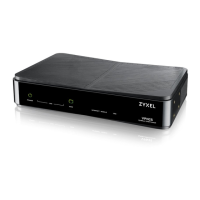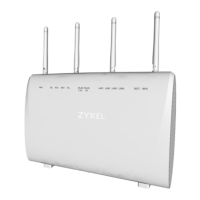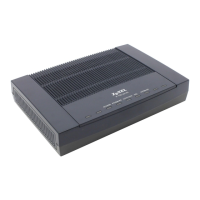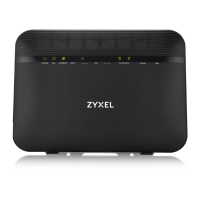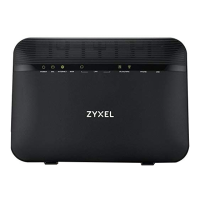Chapter 24 Multicast
VES1724-56 User’s Guide
225
IGMP Filtering Select Active to enable IGMP filtering to control which IGMP groups a subscriber on a port
can join.
Note: If you enable IGMP filtering, you must create and assign IGMP filtering profiles for the
ports that you want to allow to join multicast groups.
Proxy Select MGMDv3 Mode to enable Multicast Group Membership Discovery version three
(MGMDv3) and have the Switch send IGMPv3 or MLDv2 queries instead of IGMPv2 or
MLDv1 queries.
MGMDv2 indicates IGMPv2 in IPv4 networks and MLDv1 in IPv6 networks. MGMDv3
indicates IGMPv3 in IPv4 networks and MLDv2 in IPv6 networks.
Note: MGMDv3 only applies in IGMP proxy mode.
Unknown
Multicast Frame
Specify the action to perform when the Switch receives an unknown multicast frame.
Select Drop to discard the frame(s). Select Flooding to send the frame(s) to all ports.
Reserved Multicast
Group
Multicast addresses (224.0.0.0 to 224.0.0.255) are reserved for the local scope. For
examples, 224.0.0.1 is for all hosts in this subnet, 224.0.0.2 is for all multicast routers in
this subnet, etc. A router will not forward a packet with the destination IP address within
this range. See the IANA web site for more information.
Specify the action to perform when the Switch receives a frame with a reserved multicast
address. Select Drop to discard the frame(s). Select Flooding to send the frame(s) to all
ports.
Port This field displays the port number.
* Settings in this row apply to all ports.
Use this row only if you want to make some settings the same for all ports. Use this row
first to set the common settings and then make adjustments on a port-by-port basis.
Note: Changes in this row are copied to all the ports as soon as you make them.
Immed. Leave Select this option to set the Switch to remove this port from the multicast tree when an
IGMP version 2 leave message is received on this port.
Select this option if there is only one host connected to this port.
Max Group Num. Select Enable and enter a number (0~255) to limit the number of multicast groups this
port is allowed to join. Once a port is registered in the specified number of multicast
groups, any new IGMP join report frame(s) is dropped on this port.
IGMP Msg Limit Select Enable and enter a number (0~255) to limit the number of multicast frames this
port is allowed to flow though. New multicast frames are dropped once more than the
specified number of multicast frames flow into a port at one time.
IGMP Filtering
Profile
Select the name of the IGMP filtering profile to use for this port. Otherwise, select Default
to prohibit the port from joining any multicast group.
You can create IGMP filtering profiles in the Multicast > Multicast Setting > IGMP
Filtering Profile screen.
IGMP Querier
Mode
The Switch treats an IGMP query port as being connected to an IGMP multicast router (or
server). The Switch forwards IGMP join or leave packets to an IGMP query port.
Select Auto to have the Switch use the port as an IGMP query port if the port receives
IGMP query packets.
Select Fixed to have the Switch always use the port as an IGMP query port. Select this
when you connect an IGMP multicast server to the port.
Select Edge to stop the Switch from using the port as an IGMP query port. The Switch will
not keep any record of an IGMP router being connected to this port. The Switch does not
forward IGMP join or leave packets to this port.
Table 96 Advanced Application > Multicast > Multicast Setting (continued)
LABEL DESCRIPTION
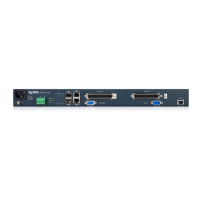
